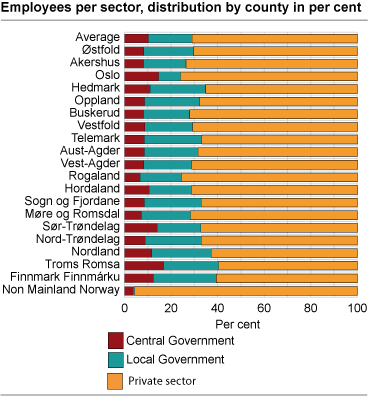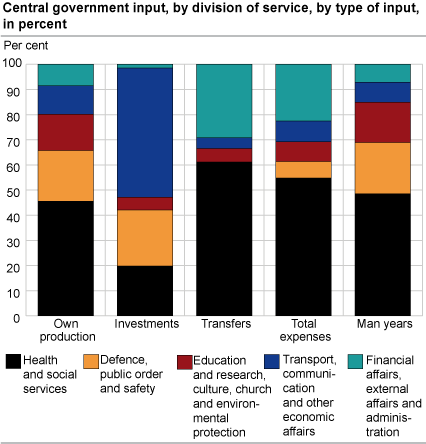Content
Published:
This is an archived release.
10 per cent employed in central government
New input statistics for central government reveal that 10 per cent of all employed persons in Norway worked in the central government sector in 2009.
In the fourth quarter of 2009, 10 per cent of all employed persons worked in central government. Comparisons within counties show that the highest share of employees working in central government was in Troms, with approximately 17 per cent. Rogaland had the lowest share, with 7 per cent. The share in Oslo was 15 per cent.
Most work full time and have long education
The share of the employed who had more than 30 settled working hours per week at their main job was highest in central government, with 80 per cent, compared to 78 per cent in county municipalities, 76 per cent in the private sector and government enterprises combined, and 58 per cent in municipalities. Furthermore, the share of the employed with 4 years or more of tertiary education was 23 per cent in central government, compared to about 22 per cent in county municipalities, 6 per cent in the private sector and government enterprises together, and 4 per cent in municipalities.
More women than men and almost one out of four above 55 years of age
Almost 60 per cent of the employed in central government were women. In comparison, the share of women was slightly less than 80 per cent in municipalities, 57 per cent in county municipalities, and 37 per cent in the private sector and government enterprises combined. The share of the employed in central government who were older than 55 years of age was 22 per cent. The share of elderly was highest in county municipalities, with 36 per cent., while the private sector and government enterprises together had the lowest share, with 18 per cent.
8 per cent immigrants
Eight per cent of the employed in central government were immigrants. In comparison, the share of immigrants was approximately 10 per cent in the private sector and government enterprises together, 9 per cent in municipalities and 6 per cent in county municipalities.
More than 50 per cent of total expenditure to health and social services
Total expenditure totalled NOK 874 billion in 2009; more than 9 per cent higher than the previous year. Approximately NOK 480 billion, or 55 per cent, is related to health and social services. The Norwegian Labour and Welfare Service and the Specialist Health Service are the principal government units in this category. Read more about activities and services of the largest government units on the StatRes main page .
In the StatRes system, the value of the government's production of goods and services is labelled own production, and is measured as the sum of wage costs and purchased goods and services. In 2009, own production constituted 27 per cent of total expenditure. More than two thirds of total expenditure was made up of transfers to other sectors, mainly social benefits to households, grants to the local government sector and foreign economic aid to other countries and international organisations.
Two kinds of employment statistics in StatResFrom 2009, StatRes also gives statistics about employed persons 15-74 years of age, by sector and selected characteristics. The term employed persons is used here to compare the central government with other sectors. This gives a different kind of employment statistics from the other statistics in StatRes about contracted man - years adjusted for long term leaves . In the statistics on employed persons, only main jobs are included. Persons with a second job in central government, but their main job in a different sector, will thus be included in the sector where their main job is. In the fourth quarter of 2009, there were about 6 000 persons who had a second job in central government, but with their main job in a different sector, and thus are not included in the number employed in central government. On the other hand, in the statistics concerning contracted man-years adjusted for long term leaves, all second jobs in central government are included and linked to each of the government units where the persons were employed. The man-years statistics also include persons above 74 years of age, who are not included in the statistics on employed persons. The statistics in StatRes about employed persons are based on two existing statistics, namely the Register-based employment statistics , which covers residents, and Employment among short-term immigrants , which covers non-residents. Residents are people who are expected to stay in Norway for at least six months. For more information can be found in these statistics. The man-years statistics is documented in the About the statistics for StatRes - Central government. |
Tables:
- Table 1 Employed persons 15-74 years, by sector. 4th quarter 2009. Number and per cent
- Table 2 Employed persons 15-74 years, by sector and sex. 4th quarter 2009. Number and per cent
- Table 3 Employed persons 15-74 years, by sector and age. 4th quarter 2009. Number and per cent
- Table 4 Employed persons 15-74 years, by sector, resident status and immigrant category. 4th quarter 2009. Number and per cent
- Table 5 Employed persons 15-74 years, by sector and level of educatioin. 4th quarter 2009. Number and per cent
- Table 6 Employed persons 15-74 years, by sector, sex and settled working hours per week. 4th quarter 2009 Per cent
- Table 7 Employed persons 15-74 years, by sector and county of work. 4th quarter 2009. Number and per cent
Contact
-
Statistics Norway's Information Centre
E-mail: informasjon@ssb.no
tel.: (+47) 21 09 46 42



